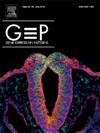横滨假胸果不同发育阶段沙漠刺猬基因(dhh)的克隆、组织分布及表达谱分析。
IF 1
4区 生物学
Q4 DEVELOPMENTAL BIOLOGY
引用次数: 0
摘要
作为Hedgehog (Hh)蛋白家族的重要成员,沙漠Hedgehog (dhh)在多种发育过程、细胞分化和组织稳态中起着至关重要的作用。然而,尚不清楚它如何调节鱼类的发育。在本研究中,我们克隆并鉴定了横滨假胸膜菌(Pseudopleuronectes yokohamae)的dhh基因。Pydhh全长cDNA全长3194 bp,开放阅读框(ORF)全长1317 bp,编码461个氨基酸的多肽,具有典型的hh -信号结构域、提示n和提示c结构域。多重序列比对表明,推测的PyDHH蛋白序列在物种间高度保守,特别是在典型结构域。系统发育分析表明,PyDHH属于胸膜形。实时荧光定量PCR结果显示,在大理石纹比目鱼的14个不同组织中检测到Pydhh,在幼鱼的9个不同组织中检测到Pydhh。在胚胎早期发育阶段,Pydhh在胚胎发育的孵化阶段表现出高水平的表达。幼鱼肝脏中Pydhh的相对表达量显著高于成鱼肝脏,雌性皮肤中Pydhh的相对表达量显著高于雄性皮肤。为了进一步研究其位置,我们进行了原位杂交(ISH)实验,结果表明杂交信号在横滨假胸膜虫的免疫器官中表达明显,在其他组织中表达较弱。我们的结果表明,Pydhh在物种中高度保守,在胚胎发育和免疫相关器官的形成中起着至关重要的作用。本文章由计算机程序翻译,如有差异,请以英文原文为准。
Cloning, tissue distribution of desert hedgehog (dhh) gene and expression profiling during different developmental stages of Pseudopleuronectes yokohamae.
As a crucial member of the Hedgehog (Hh) protein family, desert hedgehog (dhh) plays a vital role in multiple developmental processes, cell differentiation and tissue homeostasis. However, it is unclear how it regulates development in fish. In this study, we cloned and characterized the dhh gene from Pseudopleuronectes yokohamae. The full-length cDNA of Pydhh comprises 3194 bp, with a 1317 bp open reading frame (ORF) that encodes a polypeptide of 461 amino acids with a typical HH-signal domain, Hint-N and Hint-C domains. Multiple sequence alignment revealed that the putative PyDHH protein sequence was highly conserved across species, especially in the typical domains. Phylogenetic analysis showed that the PyDHH clustered within the Pleuronectiformes. Real-time quantitative PCR showed that Pydhh was detected in fourteen different tissues in adult-female and adult-male marbled flounder, and nine different tissues in juvenile fish. During early embryonic development stages, the expression of Pydhh was revealed high levels at hatching stage of embryo development. Moreover, the relative expression of Pydhh was significantly higher in the juvenile liver than adults', and higher in the female skin than the male skin. To further investigate its location, the in situ hybridization (ISH) assay was performed, the results showed that the hybridization signal was obviously expressed in the immune organs of Pseudopleuronectes yokohamae, with weak signal expression in the other tissues. Our results suggested that Pydhh is highly conserved among species and plays a vital role in embryonic development and formation of immune related organs.
求助全文
通过发布文献求助,成功后即可免费获取论文全文。
去求助
来源期刊

Gene Expression Patterns
生物-发育生物学
CiteScore
2.30
自引率
0.00%
发文量
42
审稿时长
35 days
期刊介绍:
Gene Expression Patterns is devoted to the rapid publication of high quality studies of gene expression in development. Studies using cell culture are also suitable if clearly relevant to development, e.g., analysis of key regulatory genes or of gene sets in the maintenance or differentiation of stem cells. Key areas of interest include:
-In-situ studies such as expression patterns of important or interesting genes at all levels, including transcription and protein expression
-Temporal studies of large gene sets during development
-Transgenic studies to study cell lineage in tissue formation
 求助内容:
求助内容: 应助结果提醒方式:
应助结果提醒方式:


